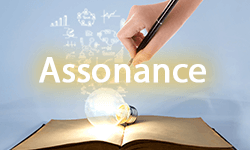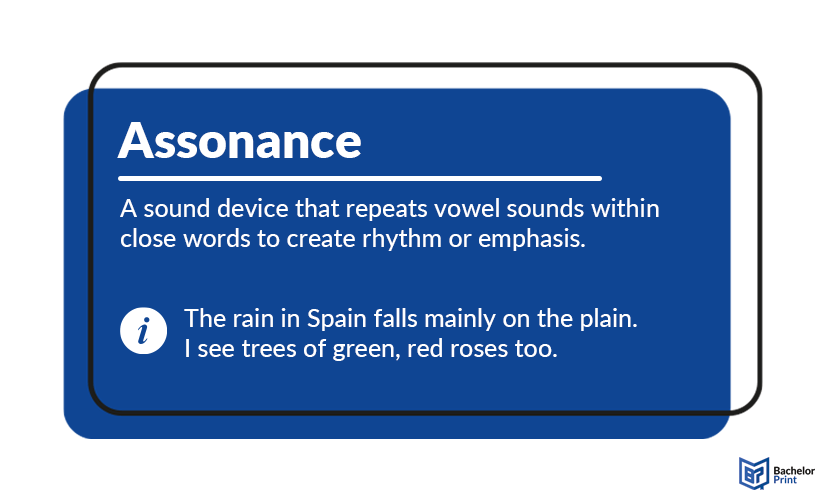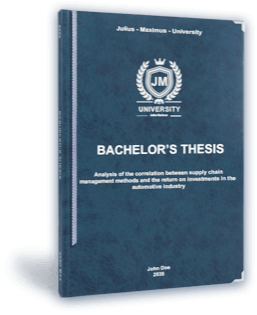
There are many ways to make your writing more entertaining and elevate your academic writing. To keep your readers from dropping your paper, offer them eloquent plays with words. One way to do this is by including an assonance, a series of words, which all include the same vowel sounds to create a rhythm and rhyme. The following article will explain everything you need to know about this stylistic device with various vivid examples.
Definition: Assonance
Assonance is also called vowel rhyme because it is based on similar-sounding vowels in multiple words of a sentence or verse. This can in some cases create an actual rhyme, but may also just imitate a rhyme through sound play. It is important to remember that an assonance relies merely on the sound and not always on the repetition of a letter, as the following examples show.

Types
There are generally three different types of assonance, which do not get differentiated in literary analyses.
Rhyme
The first one would be when the assonance also produces a rhyme. This happens when the vowel sounds are close to the end of the words. In poetry, the rhyme is usually placed at the end of the verse, but no matter how long each verse may be, every rhyme does count as an assonance.
Same vowel
The second type is that the same vowel is repeated in the subsequent words. This is probably the easiest way to create an assonance, but you also need to be careful. This stylistic device is all about the sound, not only the letter. In the following first example, you will see a wrong try, relying solely on letters, and ignoring the pronunciation, while the second example shows the right way.
Sounds
The last and most fun version is to play solely with sound. This way, you do not have to rely on rhymes or the presence of the same letter in a word. Instead, you make use of similar pronunciations, as the examples below will show.
numerous advantages for Canadian students:
- ✓ 3D live preview of your configuration
- ✓ Free express delivery for every order
- ✓ High-quality bindings with individual embossing

Use and purpose
There are a few different applications for assonance in any type of writing. Most commonly, this stylistic device is used to create a rhythm in writing. The assonant sounds make it easy to speak numerous words in a short time, which is especially necessary in song lyrics, for example.
A second application is that it can be used as an onomatopoeia. This is because a lot of “o” sounds can seem harsh, while a double “o” makes a spookier mood. E’s typically imitate a screeching sound, and even single E’s can elongate syllables. Of course, the intention can vary according to the context and this is just a general interpretation and has to be considered individually for each text.
Furthermore, it can make even a prose text more poetic and entertaining. Words that rhyme seem to stick better to our minds, engaging the reader or helping us memorize information. This is why advertisements often include rhymes or assonance to make us remember them.
Assonance vs. consonance
While many people describe assonance as a row of words with similar sounds, there is actually a more detailed differentiation. While assonance refers to only vowel rhymes, a consonance follows the same principle only with consonant sounds.
We can see in the first example that all the “o” sounds elevate the emphasis on the “boom,” the center of the song. Even if there are other sounds like the “a” in want and the “u” in hunting, if you listen to the song or speak the lyrics out loud, the vowel sound is still similar, adding to the assonance. The second example is based on the consonants “f” and “l,” repeating in the two verses and are even more emphasized by the fact that the order of “f” and “l” is reversed in the second verse, the “feeling” and “fly” is complemented by “lifestyle.”
An exception for this might be “y” because it sounds like an “I.” Since there are not many rhymes that rely solely on the letter “y,” it can still be counted as an assonance.
Most tongue twisters are actually consonances because a row of similar consonants is generally more difficult to pronounce than a repetition of vowel sounds.
Assonance vs. alliteration
An alliteration has two or more words in proximity with the same starting letter. An assonance, however, can also be an alliteration but may just as well have repeated vowels in the middle of the words or even just similar sounds instead of letters.
FAQs
An assonance is a stylistic device that uses similar-sounding vowels in subsequent words to create a poetic rhythm and rhyme.
In the case of an alliteration, the exact same letter has to be at the beginning of two or more words in a sentence. An assonance, however, can include the letters also in the middle of the word or even rely on similar sounds and pronunciations instead of strictly one letter.
Not exactly. As the repeated sound in this case is a “s,” which is no vowel, the stylistic device is called a consonance because it relies on a consonant that is repeated. Most tongue twisters are consonances because they are more difficult to pronounce in a row.
